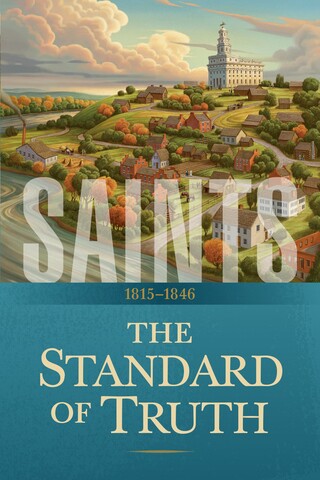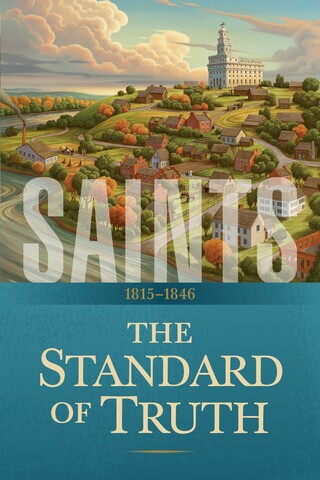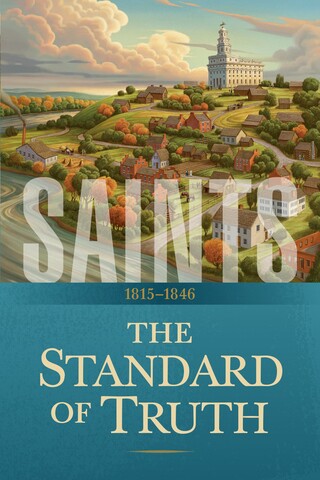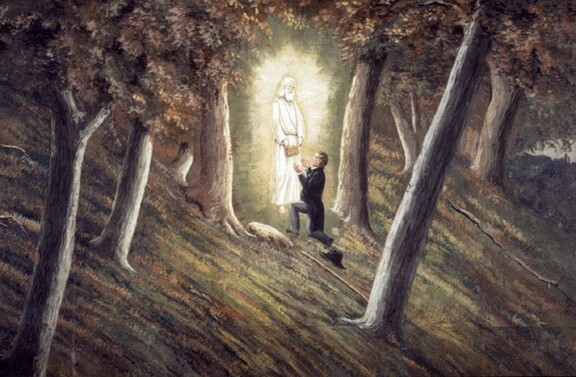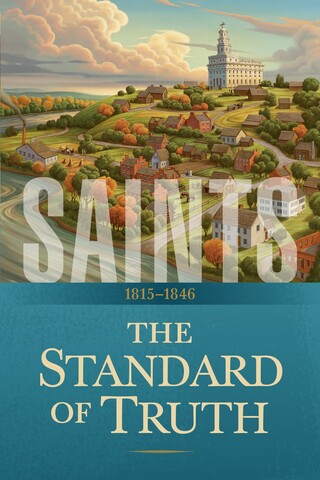The Church’s new historic book, Saints, has already been read or listened to by thousands of people. It brings a fresh perspective on the story of how the gospel and The Church of Jesus Christ evolved. While it tells many familiar stories in a conversational, dialogue-based style, there are also many stories that even avid Church history researchers might not have heard, including stories that portray the more human sides of some of our revered early Church figures. Whether you’ve already read Saints once or haven’t started it yet, here are five unique facts that you can watch for in the book.
Read the book for free on lds.org or in the Gospel Library app, or buy a paperback copy of it atdeseretbook.com.
1. Alvin was originally the person that Joseph was supposed to take to the hill with him to retrieve the gold plates.
While many of us might have heard that Joseph was instructed to bring Emma with him when he finally retrieved the plates from the hill near his Palmyra home, inchapter three of Saints, young Joseph’s conversation with the angel Moroni before he received the plates shares that there was another person named first:
“[Moroni] instructed Joseph to purify his heart and strengthen his mind to receive the record. ‘If ever these sacred things are obtained, they must be by prayer and faithfulness in obeying the Lord,’ Moroni explained. ‘They are not deposited here for the sake of accumulating gain and wealth for the glory of this world. They were sealed by the prayer of faith.’ “Joseph asked when he could have the plates. “’The twenty-second day of September next,’ Moroni said, ‘if you bring the right person with you.’ “‘Who is the right person?’ Joseph asked. “‘Your oldest brother.’ “Ever since he was a child, Joseph knew he could rely on his oldest brother. Alvin was twenty-five years old now and could have acquired his own farm if he wanted. But he had chosen to stay on the family farm to help his parents get settled and secure on their land as they got older. He was serious and hardworking, and Joseph loved and admired him immensely. “Maybe Moroni felt that Joseph needed his brother’s wisdom and strength to become the kind of person the Lord could trust with the plates.”
2. Before the Book of Mormon was published, the printer gave away some of the finished pages. Other portions of the Book of Mormon were also printed illegally by a malicious former judge.
The Book of Mormon was met with great joy and great disdain. While Thomas Marsh, who would later become the president of the Quorum of the Twelve, accepted it as the work of God, Abner Cole began printing it in his newspaper without permission, accompanying it with his own sarcastic commentary. Both stories are found in chapter eight of Saints.
Thomas Marsh
“That summer, Thomas [Marsh] felt led by the Spirit to travel hundreds of miles from his home in Boston to western New York. He stayed in the area three months before turning toward home, uncertain why he had traveled so far. At a stop along the way back, however, his host asked if he had heard about Joseph Smith’s ‘golden book.’ Thomas told the woman he had not and felt compelled to learn more. “She told him he should talk to Martin Harris and directed him to Palmyra. Thomas went there immediately and found Martin at Grandin’s printshop. The printer gave him sixteen pages of the Book of Mormon, and Thomas took them back to Boston, eager to share the first taste of this new faith with his wife, Elizabeth. “Elizabeth read the pages, and she too believed they were the work of God.”
Abner Cole
“That fall, while the printers made steady progress on the Book of Mormon, a former judge named Abner Cole began publishing a newspaper on Grandin’s press. Working at night in the shop, after Grandin’s staff went home, Abner had access to printed pages from the Book of Mormon, which were not yet bound or ready for sale. “Abner soon began poking fun at the ‘Gold Bible’ in his newspaper, and during the winter he printed excerpts from the book alongside sarcastic commentary. “When Hyrum and Oliver learned what Abner was doing, they confronted him. ‘What right have you to print the Book of Mormon in this way?’ Hyrum demanded. ‘Do you not know that we have received a copyright?’ “‘It is none of your business,’ Abner said. ‘I have hired the press and I will print what I please.’ “‘I forbid you to print any more of that book in your paper,’ Hyrum said. “‘I don’t care,’ Abner said. “Unsure what to do, Hyrum and Oliver sent word to Joseph in Harmony, who returned to Palmyra at once. He found Abner at the printing office, casually reading his own newspaper. “‘You seem hard at work,’ Joseph said. “‘How do you do, Mr. Smith,’ Abner replied dryly. “‘Mr. Cole,’ Joseph said, ‘the Book of Mormon and the right of publishing it belong to me, and I forbid you meddling with it.’ “Abner threw off his coat and pushed up his sleeves. ‘Do you want to fight, sir?’ he barked, pounding his fists together. ‘If you want to fight, just come on.’ “Joseph smiled. ‘You had better keep your coat on,’ he said. ‘It’s cold, and I am not going to fight you.’ He calmly continued, ‘But you have got to stop printing my book.’ “‘If you think you are the best man,’ Abner said, ‘just pull off your coat and try it.’ “‘There is law,’ Joseph responded, ‘and you will find that out if you did not know it before. But I shall not fight you, for that will do no good.’ “Abner knew he was on the wrong side of the law. He calmed down and stopped printing excerpts from the Book of Mormon in his newspaper.”
3. Women helped build the Kirtland temple.
Feel like women are left out of Church history? Here’s a story you’ll love about how the women of the Church helped build the Kirtland temple while many of the men were marching in the Camp of Israel (more commonly referred to as “Zion’s Camp”). It is found in chapter 19 of Saints.
“Sidney [Rigdon] had monitored the progress on the temple while Joseph was in Missouri. Lacking younger men to do the work, Artemus Millet, the superintendent of construction, had enlisted older men as well as women and children to work on the building. Many of the women took on jobs men usually filled, assisting the masons and driving wagons to and from the quarry site to haul stone for the temple. By the time Joseph and the Camp of Israel returned to Kirtland, the walls had risen several more feet above the foundation. “The return of the camp spurred construction in the summer and fall of 1834. The Saints quarried stone, hauled it to the temple lot, and built up the temple walls day by day. Joseph labored alongside workers as they cut stone blocks from a nearby creek. Some worked in the church’s sawmill preparing lumber for beams, ceilings, and floors. Others helped lift wood and rock up the scaffolding to where it was needed. “Emma and other women, meanwhile, made clothes for the workers and kept them fed. Vilate Kimball, Heber’s wife, spun one hundred pounds of wool into thread, wove it into cloth, and sewed clothes for the workers, not keeping so much as an extra pair of stockings for herself.”
4. Joseph and his younger brother, William, had a great falling out that divided the family for some time.
The disagreement started during a hearing by the Kirtland high council but escalated over the months to the point of William beating his brother up and requesting to be removed from the Quorum of the Twelve due to feelings of unworthiness. The feud divided not only the Smith family but also many members of the Church until it was resolved. The entire story can be found in chapter 20 of Saints, though only the reason for the start of the feud is included here.
“Joseph and Emma attended a meeting of the Kirtland high council. Joseph’s younger brother William had charged a woman in the church with physically abusing her stepdaughter. Among the witnesses who spoke in the case was Lucy Smith, Joseph and William’s mother. During her testimony, Joseph interrupted when she started speaking about something the council had already heard and resolved. “Leaping to his feet, William accused Joseph of doubting their mother’s words. Joseph turned to his brother and told him to sit down. William ignored him and remained standing. “‘Sit down,’ Joseph repeated, trying to stay calm. “William said he would not sit unless Joseph knocked him down. “Agitated, Joseph turned to leave the room, but his father stopped him and asked him to stay. Joseph called the council to order and finished the hearing. By the end of the meeting, he had relaxed enough to say a cordial goodbye to William. “But William was seething, still convinced that Joseph was wrong.”
5. Hyrum’s wife Mary and her sister Mercy spent a night in Liberty Jail.
Hyrum, Joseph, and several other Church leaders had spent several months in Liberty jail before Mary was able to visit her husband with their new son. The visit is recorded in chapter 32 of Saints.
“In February 1839, Hyrum’s wife, Mary, and her sister Mercy visited the prisoners with Hyrum’s newborn son, Joseph F. Smith. Mary had not seen Hyrum since before she gave birth in November. The delivery and a severe cold had left her almost too weak to travel to Liberty. But Hyrum had asked her to come, and she did not know if she would have another chance to see him. “Inside the prison, the jailer opened the trapdoor and the women descended into the dungeon to stay the night with the prisoners. He then shut the door over them and secured it with a heavy lock. “No one slept much that night. The sight of Joseph, Hyrum, and the other prisoners—gaunt and filthy in their cramped quarters—shocked the women. Hyrum held his infant son and talked quietly with Mary. He and the other prisoners were anxious. The jailer and guards were always on alert, certain that Joseph and Hyrum were plotting an escape. “The next morning, Mary and Mercy said goodbye to the prisoners and climbed out of the dungeon. As the guards showed them out, the hinges of the trapdoor squealed as it slammed shut.”
Lead image fromWikimedia Commons
Read Saints for free on lds.org or in the Gospel Library app, or buy a hard copy of it atdeseretbook.com.
